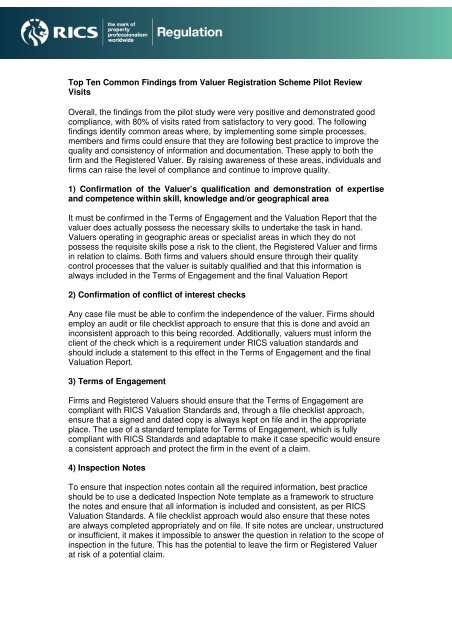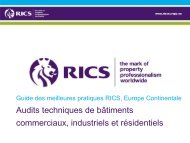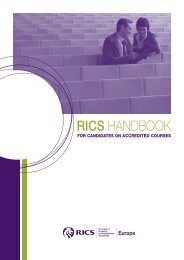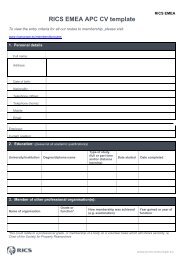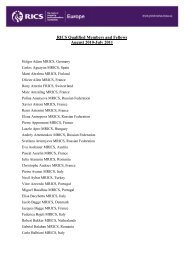Top Ten Common Findings from Valuer Registration ... - RICS Europe
Top Ten Common Findings from Valuer Registration ... - RICS Europe
Top Ten Common Findings from Valuer Registration ... - RICS Europe
Create successful ePaper yourself
Turn your PDF publications into a flip-book with our unique Google optimized e-Paper software.
<strong>Top</strong> <strong>Ten</strong> <strong>Common</strong> <strong>Findings</strong> <strong>from</strong> <strong>Valuer</strong> <strong>Registration</strong> Scheme Pilot ReviewVisitsOverall, the findings <strong>from</strong> the pilot study were very positive and demonstrated goodcompliance, with 80% of visits rated <strong>from</strong> satisfactory to very good. The followingfindings identify common areas where, by implementing some simple processes,members and firms could ensure that they are following best practice to improve thequality and consistency of information and documentation. These apply to both thefirm and the Registered <strong>Valuer</strong>. By raising awareness of these areas, individuals andfirms can raise the level of compliance and continue to improve quality.1) Confirmation of the <strong>Valuer</strong>’s qualification and demonstration of expertiseand competence within skill, knowledge and/or geographical areaIt must be confirmed in the Terms of Engagement and the Valuation Report that thevaluer does actually possess the necessary skills to undertake the task in hand.<strong>Valuer</strong>s operating in geographic areas or specialist areas in which they do notpossess the requisite skills pose a risk to the client, the Registered <strong>Valuer</strong> and firmsin relation to claims. Both firms and valuers should ensure through their qualitycontrol processes that the valuer is suitably qualified and that this information isalways included in the Terms of Engagement and the final Valuation Report2) Confirmation of conflict of interest checksAny case file must be able to confirm the independence of the valuer. Firms shouldemploy an audit or file checklist approach to ensure that this is done and avoid aninconsistent approach to this being recorded. Additionally, valuers must inform theclient of the check which is a requirement under <strong>RICS</strong> valuation standards andshould include a statement to this effect in the Terms of Engagement and the finalValuation Report.3) Terms of EngagementFirms and Registered <strong>Valuer</strong>s should ensure that the Terms of Engagement arecompliant with <strong>RICS</strong> Valuation Standards and, through a file checklist approach,ensure that a signed and dated copy is always kept on file and in the appropriateplace. The use of a standard template for Terms of Engagement, which is fullycompliant with <strong>RICS</strong> Standards and adaptable to make it case specific would ensurea consistent approach and protect the firm in the event of a claim.4) Inspection NotesTo ensure that inspection notes contain all the required information, best practiceshould be to use a dedicated Inspection Note template as a framework to structurethe notes and ensure that all information is included and consistent, as per <strong>RICS</strong>Valuation Standards. A file checklist approach would also ensure that these notesare always completed appropriately and on file. If site notes are unclear, unstructuredor insufficient, it makes it impossible to answer the question in relation to the scope ofinspection in the future. This has the potential to leave the firm or Registered <strong>Valuer</strong>at risk of a potential claim.
5) Comparables and recording of them, and additionally, referencing andanalysis of themRegistered <strong>Valuer</strong>s can most easily comply with <strong>RICS</strong> Valuation Standards bykeeping comprehensive records of comparables on file via a dedicated comparabletable template. This would ensure that all comparables are clearly documented andreferenced, together with the relevant analysis and how they influenced the valuation.By employing a suitable file checklist system, the firm can ensure that best practice isfollowed by ensuring the comparables are recorded on file appropriately. This wouldsupport the valuation if there is a claim in the future.6) Quality of reports - meeting <strong>RICS</strong> minimum requirements and/or client’sspecialist requirementsThe quality of reports can be improved by having a framework or template to followand the firm having a robust quality assurance procedure in place to ensure that allreports meet <strong>RICS</strong> minimum requirements and/or client’s specialist requirements.Where advice is not clear, poorly structured or non-compliant with <strong>RICS</strong> ValuationStandards, it can lead to bad decisions by clients and their lenders. Furthermore, itcan make defending a claim very difficult due to any failure to follow prescribedstandards7) File management and processesThe best files show an audit trail of information <strong>from</strong> first contact with the clientthrough to eventual report, with reasoning clearly demonstrated. A suitable filechecklist approach would ensure that this happens on every file.8) Quality assurance systems and protocolsThe firm should employ a suitable framework or file checklist approach to ensure allRegistered <strong>Valuer</strong>s within the firm are working to the same standard. Whereadministrative support is available within the firm, a dedicated file manager wouldalso ensure that the framework is adhered to and that every task complies with boththe firm’s protocols and <strong>RICS</strong> Valuation StandardsThe findings identified below apply primarily to the individual Registered <strong>Valuer</strong>:9) Linking the comparables and the valuation figureIt is fundamental that the file contains a clear process which links the comparableswith the valuation figure. This includes recording of thought processes and clarity ofreasoning used to arrive at the valuation. This is vital should the firm need to make adefence against any future claim and must, therefore, always form part of aRegistered <strong>Valuer</strong>’s and firms quality control/checking process.10) Valuation calculation or methodologyThis should always be the final part in providing an audit trail in respect of thevaluation figure arrived at. The best files set out a clear valuation calculation withreasoning and process which will assist in defence against any future claims. Thismust, therefore, always form part of a Registered <strong>Valuer</strong>’s and firm’s qualitycontrol/checking process.<strong>RICS</strong> would like to pass on their thanks to firms who have participated in thetesting process for their assistance and feedback to date.


